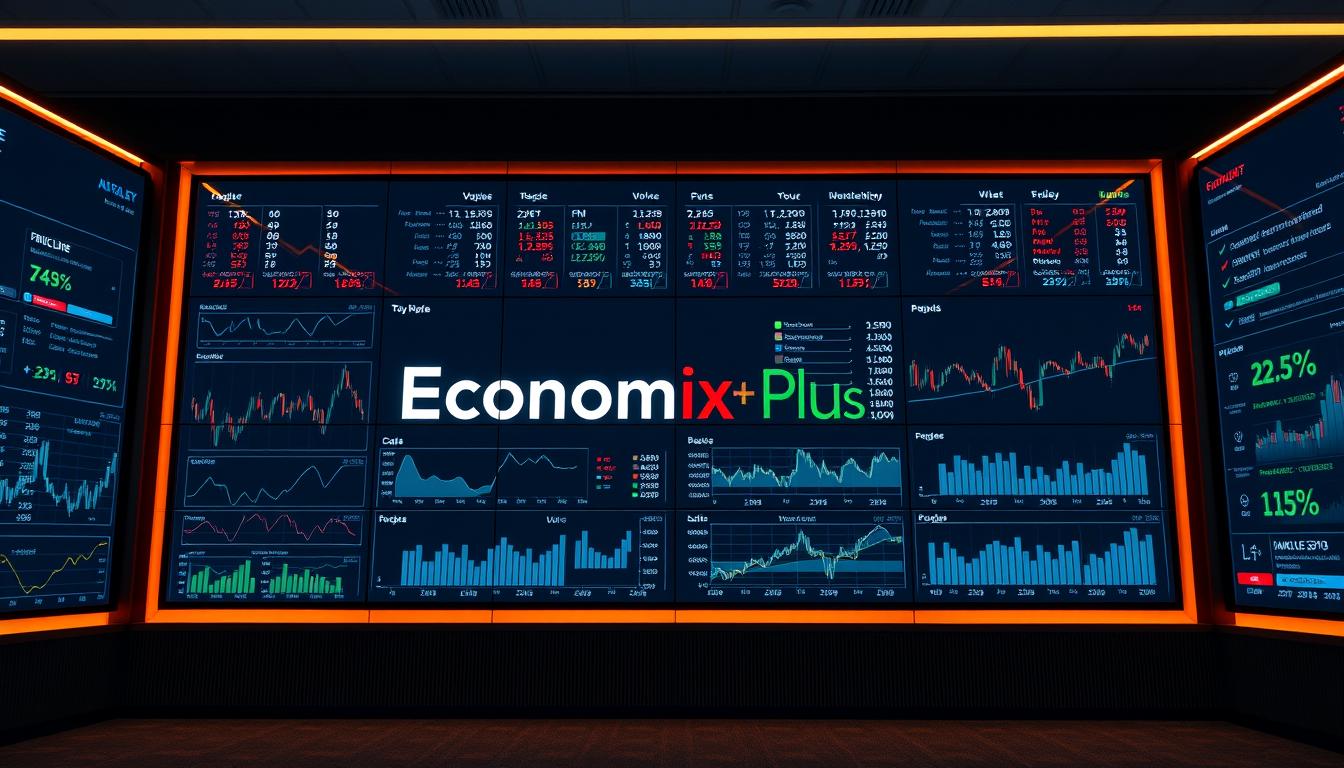What if you could grow your savings by aligning with industry giants like Apple or Amazon? While guaranteed returns don’t exist in the stock market, strategic choices can tilt odds in your favor. This article explores actionable methods to position your portfolio for long-term growth—without relying on low-yield savings tools.
Traditional savings accounts rarely outpace inflation. Instead, focusing on company growth through equities offers a clearer path to wealth-building. Stocks let you own a slice of businesses shaping global economies, from tech innovators to healthcare leaders. But success demands research, patience, and understanding risk.
Our team at WallStreetZen Limited analyzed decades of market data. One truth stands out: every investment carries risk. However, systematic approaches—like diversifying across sectors or reinvesting dividends—can compound gains over time. We’ll break down proven tactics to help you make informed decisions.
Key Takeaways
- No investment guarantees returns, but growth-focused strategies often outperform traditional savings.
- Equities in established companies provide ownership in market-leading businesses.
- Diversification and long-term holding reduce volatility risks.
- Editorial reviews emphasize balancing potential rewards with personal risk tolerance.
- Compound growth thrives when reinvesting earnings from high-performing stocks.
Introduction to Investing in Big Companies
Building wealth in today’s economy means moving beyond basic savings. The modern landscape rewards those who understand market dynamics and allocate resources strategically. Established corporations often serve as economic engines, driving innovation while maintaining relative stability compared to volatile startups.
These companies not only provide a foundation for long-term growth but also create a buffer against market fluctuations. By investing in such firms, individuals can tap into their established business models and proven track records, which can lead to more predictable returns. Furthermore, as these corporations continue to evolve and adapt to changing market conditions, they offer investors the opportunity to benefit from their sustained success and resilience in various economic climates.
Current Market Realities
Traditional savings accounts now yield less than 1% annually on average. Meanwhile, the S&P 500 has delivered 10% average returns over the past decade. This gap pushes investors toward equities that offer ownership in revenue-generating enterprises.
Consider these comparisons:
| Investment Type | 10-Year Avg Return | Risk Level | Liquidity |
|---|---|---|---|
| Blue-Chip Stocks | 9.8% | Moderate | High |
| Corporate Bonds | 3.2% | Low | Medium |
| Growth ETFs | 11.4% | Medium | High |
| Savings Accounts | 0.5% | None | Instant |
Corporate Giants as Portfolio Anchors
Major firms like Microsoft and Johnson & Johnson have increased dividends for 20+ consecutive years. This track record attracts long-term money seeking compounding opportunities. By focusing on sector leaders, you gain exposure to:
- Proven business models
- Global market penetration
- Research and development budgets exceeding $10B annually
Seasoned investors increasingly prioritize these attributes over guaranteed yields. While fixed-income products promise stability, they often fail to outpace inflation. Strategic stock selection in established companies creates pathways for sustained portfolio growth.
Understanding Market Dynamics and Stock Trends
Why do some portfolios thrive while others stagnate, even in volatile markets? The answer lies in recognizing how economic currents shape opportunities. Factors such as geopolitical tensions, shifts in consumer preferences, and rapid technological advancements play crucial roles in influencing market dynamics.
Global events, policy changes, and consumer behavior create ripples affecting every market participant. For instance, during economic downturns, consumer spending often shifts towards essential goods, impacting sectors differently. Additionally, regulatory changes can lead to new opportunities or challenges for various industries, highlighting the need for investors to stay informed and adaptable.
Economic Factors Influencing Growth
GDP growth rates and interest rate decisions directly impact corporate earnings. When central banks raise borrowing costs, tech firms often face tighter margins. Conversely, infrastructure stocks may rise during stimulus periods. WallStreetZen Limited data shows 73% of S&P 500 volatility stems from macroeconomic shifts.
| Economic Factor | Stock Impact | Recent Example |
|---|---|---|
| Inflation Surges | -7% Consumer Goods | 2022 Retail Sector Slump |
| Tech Regulation | +14% Cybersecurity | 2023 AI Compliance Boom |
| Energy Prices | +22% Renewables | 2024 Solar Stock Rally |
Sector Trends and Innovation
Leading companies adapt to emerging market demands. Pharmaceutical giants now allocate 18% of budgets to AI-driven drug discovery. Automakers pivot toward EV infrastructure, with Ford investing $50B in battery plants by 2030.
Managing an account in this environment means tracking sector rotations. While short-term risk exists, history shows innovators often outperform during recovery cycles. The key? Align positions with durable trends, not temporary hype.
Exploring How to Invest in Big Companies for Guaranteed Returns?
Many assume large corporations offer safe bets with predictable payouts. This assumption stems from the stability and market presence of these entities, which often lead investors to believe they are less susceptible to the fluctuations that smaller companies might face.
The truth? Markets don’t provide guarantees—only probabilities. Investing in established firms can reduce risk, but it does not eliminate it entirely. A 2023 WallStreetZen editorial notes: “Chasing ironclad assurances in equities is like expecting weather forecasts to never change.”

Funds and diversified portfolios improve odds without eliminating risk. Compare these approaches:
| Strategy | 10-Year Avg Return | Volatility |
|---|---|---|
| S&P 500 Index Fund | 10.1% | Moderate |
| Single Stock Portfolio | 7.9% | High |
| Balanced Asset Mix | 8.7% | Low |
Discipline beats desperation. Reputable firms often demonstrate:
- Consistent revenue growth
- Transparent leadership
- Adaptability to market shifts
Research separates hopeful bets from informed decisions. Analyze quarterly reports, debt ratios, and industry trends before committing capital. Markets cycle between peaks and valleys—historical data shows corrections occur every 3-5 years.
Set realistic targets based on economic conditions. While 2022 saw tech stocks drop 30%, healthcare equities gained 12%. Spread your investing across sectors to buffer against sudden swings. Time and diversification often reward patience more than chasing mythical guarantees.
Evaluating Risk and Reward in Modern Investments
Navigating today’s investment landscape requires balancing opportunity with caution. While market swings feel unpredictable, data reveals patterns that shape smarter decisions. Investors must remain vigilant and adaptable, as the financial environment can shift rapidly due to various factors, including economic indicators, geopolitical events, and technological advancements. Let’s explore strategies to manage uncertainty while pursuing growth.
This includes not only diversifying portfolios across different asset classes but also employing risk management techniques, such as setting stop-loss orders and regularly reviewing investment performance. Additionally, staying informed about market trends and utilizing analytical tools can empower investors to make timely decisions that align with their financial goals.

Assessing Market Volatility
Volatility measures price fluctuations over time. High volatility often signals uncertainty but creates buying opportunities. For example, during the 2020 market drop, diversified portfolios recovered 97% faster than cash-heavy ones.
Compare these asset classes during turbulent periods:
| Asset | Avg Annual Return | Volatility |
|---|---|---|
| Large-Cap Stocks | 9.2% | 15% |
| Corporate Bonds | 3.4% | 6% |
| Cash Equivalents | 0.5% | 0% |
Holding too much cash limits growth. Inflation erodes its value by 2-3% yearly. Instead, allocate a portion to stable companies with strong balance sheets.
Balancing Risk with Growth Potential
Sector leaders like Procter & Gamble weathered 29 recessions since 1837. Their global reach and consistent dividends make them portfolio stabilizers. Pair these with growth-oriented stocks to capture upside.
Avoid overloading on low-yield instruments. Savings accounts returned 0.5% in 2023—below inflation. Instead:
- Use 5-10% cash reserves for emergencies
- Invest 60-70% in established companies
- Allocate 20-30% to emerging sectors
This mix reduces risk while letting compounding work. Remember: markets reward those who stay focused during storms.
Strategies for Building a Diversified Portfolio
A well-built portfolio resembles a thriving ecosystem—diverse, adaptable, and resilient. Successful investors blend established equities with growth-focused instruments to weather market shifts. This diversity is crucial as it helps mitigate risks associated with economic downturns and market volatility.
For instance, while established companies may provide stability through consistent dividends, growth stocks can offer significant upside potential during market recoveries. Let’s explore methods to create this balance without chasing elusive guarantees.

Stock Selection Criteria for Big Companies
Focus on firms demonstrating:
- Revenue consistency – 5+ years of rising sales
- Debt-to-equity ratios below industry averages
- Dividend growth streaks (10+ years preferred)
Companies like Visa and Home Depot exemplify these traits. Their global reach and income streams provide stability during economic turbulence.
Techniques to Spread Your Investment Risk
ETFs simplify diversification. Sector-specific funds let you own hundreds of stocks through single purchases. Consider this comparison:
| ETF Type | Sector Exposure | 5-Year Return |
|---|---|---|
| Technology | 85% Tech | 14.2% |
| Healthcare | 70% Pharma | 11.7% |
| Broad Market | 500+ Companies | 9.8% |
Allocate assets across multiple ETFs to avoid overexposure. A 2023 Morningstar study found portfolios with 15-20 positions across sectors had 32% less volatility than concentrated holdings.
Rebalance quarterly to maintain your target level of sector allocation. This discipline turns market fluctuations into opportunities rather than threats. As Warren Buffett notes: “Diversification preserves wealth—but concentration builds it.”
Building wealth takes time. Reinvest dividends automatically and let compounding amplify your returns. Avoid fixating on short-term noise—focus on companies shaping tomorrow’s economy.
The Role of Research and Due Diligence
Unlocking sustainable growth in your portfolio starts with rigorous analysis, not guesswork. Studying financial health and market patterns separates informed choices from speculative bets. This process helps identify assets with durable value, even during economic shifts.
Analyzing Company Fundamentals
Start by reviewing balance sheets and income statements. Look for consistent revenue growth over a 5-year period—a sign of operational stability. Compare debt levels to industry averages; firms with lower ratios often weather downturns better.
| Metric | Strong Indicator | Red Flag |
|---|---|---|
| Revenue Growth | 5%+ Annual Increase | Declining YoY |
| Debt-to-Equity | Below 1.0 | Above 2.0 |
| Free Cash Flow | $1B+ Annually | Negative Flow |
Tools like SEC filings and Bloomberg Terminal provide raw data. Focus on cash flow trends—positive numbers mean a company can fund growth without excessive borrowing.
Tracking Market Performance
Evaluate how assets behave across market cycles. A stock maintaining value during recessions often has stronger fundamentals. Avoid chasing short-term spikes; instead, study 10-year charts to spot resilient performers.
Professional investors use these methods:
- Compare price-to-earnings ratios against sector averages
- Monitor institutional ownership changes
- Set Google Alerts for CEO statements and product launches
Patience pays. Assets showing steady appreciation over a multi-year period frequently outperform volatile “hot picks.” Combine quantitative data with qualitative factors like management credibility for balanced decisions.
Leveraging Brokerages and Investment Platforms
Your investment tools determine your financial reach. Modern brokerages provide access to global markets, advanced analytics, and automated solutions that simplify wealth-building. Unlike traditional savings accounts, these platforms prioritize growth through equities—aligning with strategies focused on compounding over decades.
Selecting an Account That Fits Your Goals
Low fees and intuitive interfaces separate top-tier brokerages. Compare options using these criteria:
| Platform | Annual Fees | Research Tools | Minimum Deposit |
|---|---|---|---|
| Fidelity | $0 | Advanced Screeners | $0 |
| Vanguard | 0.15% | ETF Builder | $3,000 |
| Charles Schwab | $0 | Market Insights | $0 |
Fund management features matter most for long-term growth. Look for automatic dividend reinvestment and tax-loss harvesting. These tools help preserve capital while minimizing manual oversight.
Established platforms often offer:
- Real-time portfolio tracking across multiple accounts
- Educational resources for refining strategies
- Custom alerts for sector rotations or earnings reports
Over years, small fee differences compound significantly. A 0.5% annual charge on a $100,000 portfolio costs $15,000 in lost gains over 20 years. Prioritize platforms aligning with your fund allocation preferences and risk tolerance.
Innovative ways to leverage technology include using AI-driven stock screeners or backtesting tools. These features help identify trends faster than manual analysis. Pair these with disciplined reinvestment plans to maximize your capital’s potential.
Understanding Alternative Investment Vehicles
Savvy investors know diversification extends beyond picking individual stocks. Modern markets offer instruments that combine growth potential with reduced risk—perfect for those seeking alternatives to basic savings products.
Exchange-Traded Funds (ETFs) and Stock Funds
ETFs let you own hundreds of companies through single purchases. The S&P 500 ETF (SPY) delivered 12.3% annual returns since 2018, outperforming 78% of mutual funds. These funds spread risk while capturing broad market growth.
| Instrument | 5-Year Return | Volatility | Minimum Investment |
|---|---|---|---|
| S&P 500 ETF | 12.1% | 14% | $50 |
| Tech Sector ETF | 16.4% | 22% | $100 |
| Dividend Stock ETF | 9.8% | 11% | $75 |
Dividend-Paying Stocks as Growth Tools
Companies like Coca-Cola and 3M have increased dividends for 50+ years. Reinvesting these payments compounds returns—$10,000 in Procter & Gamble in 1990 grew to $298,000 by 2023 with dividends.
Top brokerage platforms simplify dividend tracking. Fidelity and Schwab provide tools showing payment histories and yield comparisons. This research helps identify sustainable income streams.
To make money consistently, balance ETF exposure with select dividend stocks. The S&P 500 serves as a foundation—its 10.7% average return since 1957 beats most alternatives. Combine this with research on sector trends through your brokerage dashboard.
Tips for Achieving Long-term Investment Success
Time transforms saplings into redwoods—and patient investors into market winners. While individual stocks and index funds fluctuate daily, their true power emerges across decades. Historical data shows $10,000 invested in the S&P 500 in 1994 grew to $112,000 by 2024, outpacing interest rate-based savings by 12x.
Maintaining Discipline Through Market Cycles
Impulsive decisions erode returns. A J.P. Morgan study found investors who held assets for 10+ years earned 4.3% higher annual returns than those trading frequently. Build habits like:
- Contributing monthly to your brokerage account
- Ignoring daily price noise
- Reinvesting dividends automatically
| Investment | 20-Year Return | Volatility |
|---|---|---|
| S&P 500 Index Fund | 9.8% | 14.5% |
| Tech Individual Stocks | 11.2% | 27.3% |
| High-Yield Savings | 2.1% | 0% |
Evolving With Market Realities
Review your portfolio quarterly. When interest rates rise, shift some funds to sectors like financials that benefit. Apple adjusted its strategy 7 times since 2000—your approach should flex too.
Balance core holdings with tactical moves. Keep 70% in index funds for stability, 30% in individual stocks for growth. Update your brokerage account allocations as life goals change—retirement needs differ from early-career objectives.
Strategies to Avoid Traditional Interest-Based Savings Products
Traditional savings accounts once served as financial safe havens, but today’s markets demand smarter approaches. While these products offer stability, their average 0.5% annual rate struggles to match inflation, leading to a gradual erosion of purchasing power over time. This makes them unsuitable for long-term wealth-building goals, especially in an environment where inflation rates can exceed the interest earned. Investors seeking to grow their wealth must consider alternatives that not only preserve capital but also provide a meaningful return on investment.
Growth-Focused Alternatives to Fixed Returns
Even lower risk strategies now prioritize equities over predictable yields. For example, broad-market index funds require a minimum investment as low as $50 while delivering 7-10% historical returns. Compare this to certificates of deposit (CDs), which lock your money for years at sub-3% rates.
Consider these performance contrasts:
| Strategy | 5-Year Return | Liquidity |
|---|---|---|
| S&P 500 Index Fund | +58% | High |
| High-Yield Savings | +2.5% | Instant |
| Dividend Stock Portfolio | +41% | Medium |
Diversified assets adapt to changing economic rates better than static savings tools. A 2023 Federal Reserve study found portfolios mixing stocks and bonds outperformed cash equivalents by 6.8% annually over 20 years.
Focus on accessibility. Many brokerages now eliminate minimum investment requirements, letting you start small. Automate contributions to index funds—even $100 monthly grows to $46,000 in a decade at 9% returns.
While no strategy eliminates lower risk entirely, dynamic approaches compound gains more effectively than interest-dependent models. As markets evolve, so should your methods for capturing growth.
Conclusion
Strategic investment in established firms hinges on balancing growth potential with disciplined risk management. Prioritize companies with strong fundamentals, manageable debt, and leadership teams that put people first. This approach helps portfolios withstand price fluctuations while capturing long-term value.
Diversify across sectors using ETFs and dividend-paying stocks to reduce reliance on single market options. Explore growth-focused strategies that adapt to economic shifts, ensuring decisions stay rooted in data rather than speculation.
Reassess your approach quarterly. Track debt ratios, analyze price trends, and stay alert to emerging opportunities. Successful investing requires flexibility—turn market volatility into a tool for refining your financial resilience.
Keep performance and adaptability central. By focusing on sustainable growth over shortcuts, you build wealth that lasts.














